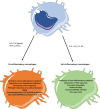Modulation of Macrophage Immunometabolism: A New Approach to Fight Infections
- PMID: 35154105
- PMCID: PMC8825490
- DOI: 10.3389/fimmu.2022.780839
Modulation of Macrophage Immunometabolism: A New Approach to Fight Infections
Abstract
Macrophages are essential innate immune cells that contribute to host defense during infection. An important feature of macrophages is their ability to respond to extracellular cues and to adopt different phenotypes and functions in response to these stimuli. The evidence accumulated in the last decade has highlighted the crucial role of metabolic reprogramming during macrophage activation in infectious context. Thus, understanding and manipulation of macrophage immunometabolism during infection could be of interest to develop therapeutic strategies. In this review, we focus on 5 major metabolic pathways including glycolysis, pentose phosphate pathway, fatty acid oxidation and synthesis, tricarboxylic acid cycle and amino acid metabolism and discuss how they sustain and regulate macrophage immune function in response to parasitic, bacterial and viral infections as well as trained immunity. At the end, we assess whether some drugs including those used in clinic and in development can target macrophage immunometabolism for potential therapy during infection with an emphasis on SARS-CoV2 infection.
Keywords: SARS – CoV – 2; immunometabolism; infections; macrophage; therapeutics.
Copyright © 2022 Gauthier and Chen.
Conflict of interest statement
The authors declare that the research was conducted in the absence of any commercial or financial relationships that could be construed as a potential conflict of interest.
Figures


Similar articles
-
Macrophage immunometabolism dysregulation and inflammatory disorders.Biomed Pharmacother. 2025 Jul;188:118142. doi: 10.1016/j.biopha.2025.118142. Epub 2025 May 15. Biomed Pharmacother. 2025. PMID: 40378771 Review.
-
Decoding macrophage immunometabolism in human viral infection.Adv Protein Chem Struct Biol. 2024;140:493-523. doi: 10.1016/bs.apcsb.2023.12.003. Epub 2024 Mar 13. Adv Protein Chem Struct Biol. 2024. PMID: 38762278 Review.
-
Macrophage Immunometabolism: Where Are We (Going)?Trends Immunol. 2017 Jun;38(6):395-406. doi: 10.1016/j.it.2017.03.001. Epub 2017 Apr 7. Trends Immunol. 2017. PMID: 28396078 Review.
-
Immunometabolism of Macrophages in Bacterial Infections.Front Cell Infect Microbiol. 2021 Jan 29;10:607650. doi: 10.3389/fcimb.2020.607650. eCollection 2020. Front Cell Infect Microbiol. 2021. PMID: 33585278 Free PMC article. Review.
-
How could we forget immunometabolism in SARS-CoV2 infection or COVID-19?Int Rev Immunol. 2021;40(1-2):72-107. doi: 10.1080/08830185.2020.1840567. Epub 2020 Nov 6. Int Rev Immunol. 2021. PMID: 33155525 Review.
Cited by
-
The mitochondrial gene-CMPK2 functions as a rheostat for macrophage homeostasis.Front Immunol. 2022 Nov 14;13:935710. doi: 10.3389/fimmu.2022.935710. eCollection 2022. Front Immunol. 2022. PMID: 36451821 Free PMC article.
-
Early suppression of antiviral host response and protocadherins by SARS-CoV-2 Spike protein in THP-1-derived macrophage-like cells.Front Immunol. 2022 Oct 20;13:999233. doi: 10.3389/fimmu.2022.999233. eCollection 2022. Front Immunol. 2022. PMID: 36341352 Free PMC article.
-
Roles of Critical Amino Acids Metabolism in The Interactions Between Intracellular Bacterial Infection and Macrophage Function.Curr Microbiol. 2024 Jul 20;81(9):280. doi: 10.1007/s00284-024-03801-x. Curr Microbiol. 2024. PMID: 39031203 Review.
-
Effects of eicosapentaneoic acid on innate immune responses in an Atlantic salmon kidney cell line in vitro.PLoS One. 2024 May 28;19(5):e0302286. doi: 10.1371/journal.pone.0302286. eCollection 2024. PLoS One. 2024. PMID: 38805503 Free PMC article.
-
Interaction with IGF1 overrides ANXA2-mediated anti-inflammatory functions of IGFBP5 in vivo.Front Immunol. 2025 Jan 10;15:1539317. doi: 10.3389/fimmu.2024.1539317. eCollection 2024. Front Immunol. 2025. PMID: 39867883 Free PMC article.
References
Publication types
MeSH terms
LinkOut - more resources
Full Text Sources
Miscellaneous

